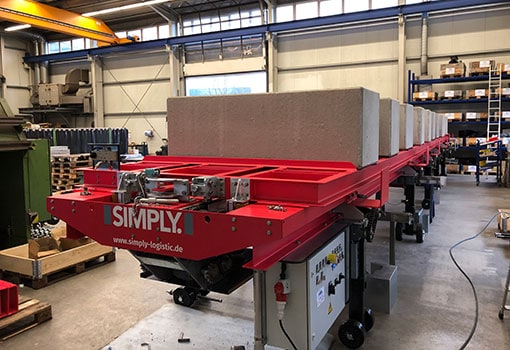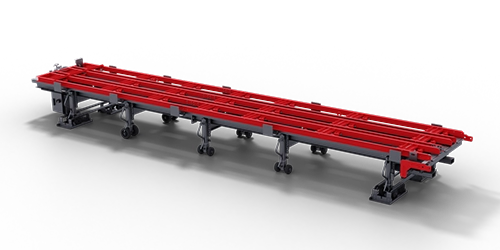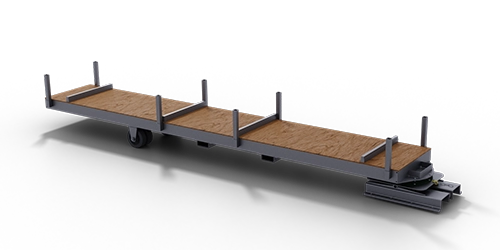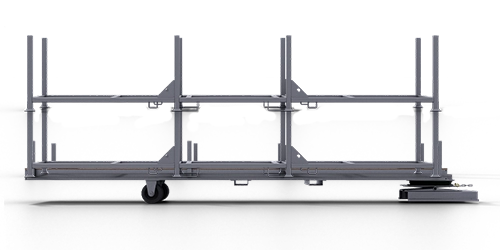The principle of a container is simple, but this doesn’t always apply to loading it. The error probability increases as soon as the cargo is heavy or bulky.
This endangers both the workers and the load. Irrespective of how you go about it, the initial situation is always the same: the cargo has to go into the container. No matter how. And somehow it has always worked up to now. The emphasis, however, is always on „somehow“.
Potential Problem of Loading Goods
At the start, a series of improvisations has resulted in heavy equipment in the form of forklifts or cranes. If the cargo gets a bit longer then it won’t be the first time that two forklifts are used.
A lot can already happen in this case: the cargo has to be lifted so that the forks can push under it and this in turn requires a cable which can break whilst the crane is suspending it. Or you can try without a cable, which runs the risk of damaging the cargo with the forklift forks.
Of course it is possible that the cargo is placed on a pallet which can be lifted to the right height in the end – as long as it doesn’t break. No matter what happens the driver is practically blind if he has several metres of cargo in front of him and the view to the left and the right is blocked as well. After this the problem is to position the thing more or less at right angles to the container. An experienced driver can manage this – as long as the load is correctly balanced. And his colleagues can act as banksmen and can be seen.
The next stage in this type of container loading consists of moving the cargo into the container, and this is where ingenuity is required. This is where a variety of rather daring in-house structures as well as home-made extensions to the forklift forks in order to shift the cargo into the container somehow can be found. It’s probably best not to ask about MOT approval and the requirements of your transport insurance.
The load is brought up to container height somehow or other, where some more workers are waiting to attempt to position and fix the load by hand. The only thing they can see is several tonnes of cargo being pushed towards them. And they just have to hope the guy in charge can see if corrections are necessary and if the whole thing has to be stopped in time. While he’s lying head down on the container. The fact that this type of container loading doesn’t work without slips – in the literal sense – goes without saying. The same applies to the associated hazards both for the loads and for the workers. If the forklift pushes the load too close to one of the workers we’ll just have to hope that he can jump to the side, because the load can’t. Damage is par for the course if the load collides with other goods already in the container. And that’s more than just annoying. Damaged cargo can no longer be used and may even need to be produced again. Further follow-on costs result from guarantee and regress claims. After all the customer actually wants to use the product, and he wants to do this as quickly as possible.
But let’s just assume that everything has gone well up to now. Even if it took a while, which blocked valuable workers and expensive equipment.
Now it’s the turn of the workers in the container who have to fix things which don’t even have standard dimensions, let alone right angles or a square shape, in a complete lack of space and light.
Things get dangerous if the load slips in the container! Especially since there isn’t much room for dodging.
Why Using Container Loading System
Bearing these challenges in mind it would be best from the industrial safety point of view to simply stop loading containers.
Of course you can’t do that, so it’s about time you started looking for an alternative. The open-top container has established itself as a possible solution here. But skill and heavy equipment is required here as well.
And you’ll still have to give several of your workers some careful training. However on the plus side there are time and safety gains, even if this type of loading still takes a while. The first price you have to pay for this is existing material and personnel costs. And an open-top container costs more. In Addition, it is not available as often as a normal container and its deployment has to be individually planned.
All the above results in a wish for container loading equipment. Especially since standardised workflows are a priority requirement for container intra-logistics.
And this is why the best container loading equipment is a container loading system. And SIMPLY. provides the best answer if you are dealing with heavy, bulky goods which need to be loaded quickly and safely. For container intra-logistics which are just as economical as they are plannable. And which save resources.
After all, the buzzword with SIMPLY. is „loading the container before the container.“
And not when the HGV is already waiting in the yard, but a lot earlier. Under ideal space, light and time conditions. The cargo itself is placed on a wooden pallet which can be made in your works, and is therefore flexible for every type of cargo. The carrying capacity is 30 tonnes. Two methods have worked themselves out: the pallet is placed on the ground. You can now attach the lifting ropes and fix them so that they neither break or get in the way. Or the palette is just lifted directly on the SIMPLY. frame. A safe working platform is available left and right. And after this the cargo is pre-commissioned in peace and quiet. And completely without risk!
The loading process itself is started by a worker who presses a button. And that is simply a safe way of working. And workers in the container? No longer required!
SIMPLY. saves time, workers and makes you independent of open-top containers, pays itself off – and the safety gains are priceless!






